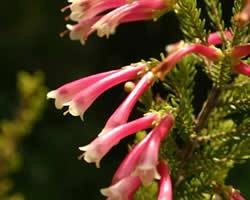Erica oatesii
(Erica oatesii)

Description
Erica is a genus of roughly 857 species of flowering plants in the family Ericaceae. The English common names heath and heather are shared by some closely related genera of similar appearance. The genus Calluna was formerly included in Erica – it differs in having even smaller scale-leaves (less than 2–3 mm long), and the flower corolla consisting of separate petals. Erica is sometimes referred to as "winter (or spring) heather" to distinguish it from Calluna "summer (or autumn) heather". Most of the species of Erica are small shrubs from 20–150 cm (8–59 in) high, though some are taller; the tallest are E. arborea (tree heath) and E. scoparia (besom heath), both of which can reach up to 7 m (23 ft) tall. All are evergreen, with minute, needle-like leaves 2–15 millimetres (0.079–0.591 in) long. Flowers are sometimes axillary, and sometimes borne in terminal umbels or spikes, and are usually outward or downward facing. The seeds are very small, and in some species may survive in the soil for decades. Dulfer published the last revision of the genus Erica in the 1960s, treating 605 species. Many new species have subsequently been described (particularly in South Africa) and a further 83 have been included in Erica from former “minor genera”, such as Phillipia Klotzsch and Blaeria L. A more recent overview of Erica species is provided in an electronic identification aid, but a modern taxonomic revision of the genus as a whole is still lacking. A number of increasingly detailed phylogenetic hypotheses for Erica have been published based on nuclear ribosomal and plastid DNA sequences.The closest relatives of Erica are Daboecia (one or two species) and Calluna (monospecific), representing the oldest surviving lineages of a, by inference, ancestrally Palearctic tribe Ericeae. The small number of European Erica species represent the oldest lineages of the genus, within which a single, order-of-magnitude more species-rich, African clade is nested. Within the African clade, Cape and Madagascan/Mascarene species respectively represent monophyletic groups. Like most Ericaceae, Erica species are mainly calcifuges, being limited to acidic or very acidic soils. In fact, the term "ericaceous" is frequently applied to all calcifuges, and to the compost used in their cultivation. Soils range from dry, sandy soils to extremely wet ones such as bog. They often dominate dwarf-shrub habitats (heathland and moorland), or the ground vegetation of open acidic woodland.
Taxonomic tree:







